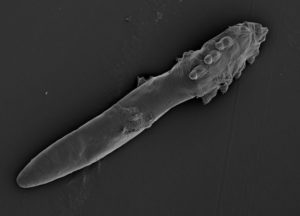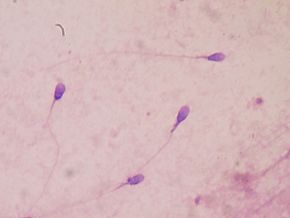 We can't see them, but we all have little face mites that live in our faces, specifically in hair follicles. The scientific name of the face mites: Demodex folliculorum. There are at least 4 lineages of face mites that correspond to different regions of the world. Good thing they're harmless (we think).Gross but fascinating. From Wired:
We can't see them, but we all have little face mites that live in our faces, specifically in hair follicles. The scientific name of the face mites: Demodex folliculorum. There are at least 4 lineages of face mites that correspond to different regions of the world. Good thing they're harmless (we think).Gross but fascinating. From Wired:
Your Face Is Covered in Mites, and They’re Full of Secrets
WHEN YOU LOOK in the mirror, you’re not just looking at you—you’re looking at a whole mess of face mites. Yeah, you’ve got ‘em. Guaranteed. The little arachnids have a fondness for your skin, shoving their tubular bodies down your hair follicles, feeding on things like oil or skin cells or even bacteria. The good news is, they don’t do you any harm. The better news is, they’ve got fascinating secrets to tell about your ancestry.
New research out today in the Proceedings of the National Academy of Sciences reveals four distinct lineages of the face mite Demodex folliculorum that correspond to different regions of the world. African faces have genetically distinct African mites, Asian faces have Asian mites, and so too do Europeans and Latin Americans have their own varieties. Even if your family moved to a different continent long ago, your forebears passed down their brand of mites to their children, who themselves passed them on down the line.
Looking even farther back, the research also hints at how face mites hitchhiked on early humans out of Africa, evolving along with them into lineages specialized for certain groups of people around the planet. It seems we’ve had face mites for a long, long while, passing them back and forth between our family members and lovers with a kiss—and a little bit of face-to-face skin contact.
Leading the research was entomologist Michelle Trautwein of the California Academy of Sciences, who with her colleagues scraped people’s faces—hey, there are worse ways to make a living—then analyzed the DNA of all the mites they’d gathered. “We found four major lineages,” says Trautwein, “and the first three lineages were restricted to people of African, Asian, and Latin American ancestry.”
The fourth lineage, the European variety, is a bit different. It’s not restricted—it shows up in the three other groups of peoples. But Europeans tend to have only European mites, not picking up the mites of African, Asian, or Latin American folks. (It should be noted that the study didn’t delve into the face mites of all the world’s peoples. The researchers didn’t test populations like Aboriginal Australians, for instance, so there may be still more lineages beyond the four.)
So what’s going on here? Well, ever since Homo sapiens radiated out of Africa, those four groups of people have evolved in their isolation in obvious ways, like developing darker or lighter skin color. But more subtly, all manner of microorganisms have evolved right alongside humans. And with different skin types come different environments for tiny critters like mites.

 A University of Georgia review study of the research literature shows that drinking coffee (instead of a caffeine supplement) improves athletic endurance performance. Also, that caffeine from coffee has
A University of Georgia review study of the research literature shows that drinking coffee (instead of a caffeine supplement) improves athletic endurance performance. Also, that caffeine from coffee has  The important thing learned from this study (though it was done in the laboratory and not directly on humans) is that it supports that apigenin (in the same chemical group as flavonoids) is important for neuron formation and for strengthening connections between brain cells.
The important thing learned from this study (though it was done in the laboratory and not directly on humans) is that it supports that apigenin (in the same chemical group as flavonoids) is important for neuron formation and for strengthening connections between brain cells.  Recent research looked at environmental causes of male infertility, specifically endocrine-disrupting chemicals.
Recent research looked at environmental causes of male infertility, specifically endocrine-disrupting chemicals. It seems that a lot has been written about the health benefits of some berries, such as blueberries, while other berries have been neglected. This study focused on red raspberries, black raspberries, and blackberries. While the study was done in Poland, it was pointed out that these berries are also commonly grown in the USA. Red raspberry, black raspberry, and blackberry fruits are abundant in dietary phytochemicals such as flavonols, phenolic acids, ellagitannins, vitamins C and E, folic acid, and β-sitosterol. Many of these bioactive compounds exhibit antioxidant activity. Anthocyanins and other phenolic compounds such as ellagitannins and ellagic acid, which distinguish raspberry from other berries, occur in high levels and are mainly responsible for their broad beneficial health properties (including anti-inflammatory, antimicrobial, and antiviral activities).
It seems that a lot has been written about the health benefits of some berries, such as blueberries, while other berries have been neglected. This study focused on red raspberries, black raspberries, and blackberries. While the study was done in Poland, it was pointed out that these berries are also commonly grown in the USA. Red raspberry, black raspberry, and blackberry fruits are abundant in dietary phytochemicals such as flavonols, phenolic acids, ellagitannins, vitamins C and E, folic acid, and β-sitosterol. Many of these bioactive compounds exhibit antioxidant activity. Anthocyanins and other phenolic compounds such as ellagitannins and ellagic acid, which distinguish raspberry from other berries, occur in high levels and are mainly responsible for their broad beneficial health properties (including anti-inflammatory, antimicrobial, and antiviral activities). Loneliness or social isolation is a health risk that can increase the risk of chronic illness and premature death.
Loneliness or social isolation is a health risk that can increase the risk of chronic illness and premature death. A newly published study reviewed 61 studies that looked at daily tree nut consumption on cardiovascular risk factors and found many health benefits. Tree nut (walnuts, almonds, pistachios, macadamia nuts, pecans, cashews, hazelnuts, and Brazil nuts) consumption lowers total cholesterol, LDL cholesterol, triglycerides, and ApoB, the primary protein in LDL cholesterol. It appeared that nut dose is more important than nut type in lowering cholesterol. The beneficial health effects are greater at about 60 grams (about 2 oz or 2 servings) or more nuts consumed per day, but positive health effects are also found at one serving per day. Five studies found that 100 g nuts per day lowered concentrations of LDL cholesterol by up to 35 mg/dL - an effect size comparable to some statin regimens.
A newly published study reviewed 61 studies that looked at daily tree nut consumption on cardiovascular risk factors and found many health benefits. Tree nut (walnuts, almonds, pistachios, macadamia nuts, pecans, cashews, hazelnuts, and Brazil nuts) consumption lowers total cholesterol, LDL cholesterol, triglycerides, and ApoB, the primary protein in LDL cholesterol. It appeared that nut dose is more important than nut type in lowering cholesterol. The beneficial health effects are greater at about 60 grams (about 2 oz or 2 servings) or more nuts consumed per day, but positive health effects are also found at one serving per day. Five studies found that 100 g nuts per day lowered concentrations of LDL cholesterol by up to 35 mg/dL - an effect size comparable to some statin regimens. Data from 2 huge studies was analyzed and found that vigorous exercise and other healthy habits seems to cut the chance of developing aggressive and lethal prostate cancer up to 68 percent in men over 60. The beneficial lifestyle habits are: weekly vigorous exercise or activity to the point of sweating, at least 7 servings of tomatoes a week, at least one serving of fatty fish per week, reduced intake of processed meat, and being a long-term non-smoker.
Data from 2 huge studies was analyzed and found that vigorous exercise and other healthy habits seems to cut the chance of developing aggressive and lethal prostate cancer up to 68 percent in men over 60. The beneficial lifestyle habits are: weekly vigorous exercise or activity to the point of sweating, at least 7 servings of tomatoes a week, at least one serving of fatty fish per week, reduced intake of processed meat, and being a long-term non-smoker.